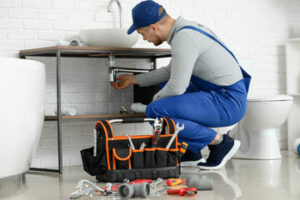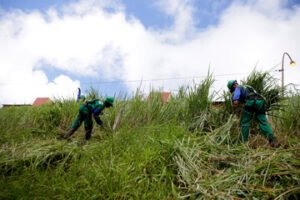Plumbers Bradenton install, repair, and maintain the pipes that deliver water and gas to homes and businesses. They also inspect plumbing fixtures, such as bathtubs, sinks, and toilets, and appliances like dishwashers and washing machines.

Plumbers often work with customers and must be able to explain technical issues in straightforward terms. They may also need to work evenings and weekends when dealing with emergency situations.
Sewer line problems are some of the worst nightmares a homeowner can face. Not only is sewage backup an incredibly messy and unpleasant experience, but it can also lead to significant water damage and costly repairs. The key to avoiding these problems is preventative maintenance. The best way to keep your sewer lines functioning properly is to schedule regular cleanings and inspections.
A professional plumber can use specialized equipment to visually inspect the condition of your sewer lines and clear out any blockages. They can also install backwater prevention valves to protect your home from sewage backflow during heavy rainfall or flooding.
The age and condition of your sewer line will affect how often it needs to be cleaned or repaired. In general, it is a good idea to have these lines cleaned every 18 months to ensure they are free of debris that could cause blockages or damage your pipes.
During a regular sewer line cleaning, your plumber will use high-pressure water to scour the interior surfaces of the pipe. They may also use a drain snake to break up and remove any clogs.
Non-flushable items are the most common cause of clogs in sewer lines. Paper towels, reusable wipes, and feminine products all build up along the path of the sewer line and can create a full-on sewage backup if they are not flushed correctly. It is important to educate your household on proper waste disposal to help prevent these problems.
Tree roots are another common cause of sewer line issues. The roots of plants naturally seek out any available water, and they will enter your sewer lines if they find a crack or poorly sealed joint. To reduce the likelihood of root penetration, it is a good idea to plant trees and shrubs far from your sewer line. You should also watch for any changes in flow down your drains, as this can indicate a problem with the line.
Many homeowners believe that the city’s sewer main is responsible for all of their plumbing issues, but this is not always the case. The tiny pipes that connect to your home’s sewer system are your responsibility, and they can become clogged with grease and other debris if not managed properly. To avoid these problems, be sure to regularly clean your eavestroughs and drain traps, and avoid pouring grease down the drains. In addition, plant trees and shrubs far from your sewer lines, and clean out any clogged cleanouts.
Sewer Repair
Sewer line problems can be disruptive, costly, and dangerous. But there are ways to mitigate damage and reduce the need for expensive repairs and replacements. By taking the time to perform regular maintenance, paying attention to warning signs, and calling in professionals when needed, you can extend the life of your sewer lines.
Plumbing technology has come a long way since the days when the only solution to a broken pipe was to dig up your yard like a makeshift archaeological site. Modern innovations like trenchless repair methods, high-definition sewer camera inspections, and pipe relining techniques have revolutionized how plumbers address sewer issues. These advances allow for more efficient and cost-effective solutions that are also better for the environment.
The first step in any sewer repair process is an inspection. Using a snake attached to a video camera, your plumber will check for blockages, breaks, and other problems. This inspection can also reveal if you have tree roots invading your pipes, which can often be solved with root removal tools.
A clogged drain or toilet is one of the most obvious signs that your sewer line needs repair. But a backed-up toilet isn’t just inconvenient—it’s also a health hazard that could lead to raw sewage spilling out of your home and into your yard.
Other common signs of a failing sewer line include repeated clogs, gurgling sounds coming from drains, and visible damage to your landscaping or lawn. If you notice any of these issues, call your plumber for an inspection right away.
Once your plumber has identified the problem, they can begin repairing or replacing your sewer line. In most cases, a spot repair is enough to restore proper function and prevent further damage. Your plumber may use slip lining, patching, or mechanical point repair to fix the affected area. For more serious damage or collapsed pipes, excavation and full replacement may be necessary.
While a sewer line replacement can be expensive, it’s sometimes unavoidable. The incessant flow of sewage and water can wear down pipes over time, leading to cracks, fractures, or complete collapse. Older pipes made from Orangeburg, clay, or cast iron can also deteriorate and break down over time. In some cases, a complete replacement is the only way to get your system back up and running.
Sewer Replacement
Sewer line replacements are a major undertaking that can disrupt a homeowner’s daily routine. Understanding the timeline of this process helps homeowners prepare, budget and make alternative accommodations as needed.
The main sewer line connects your home to the city’s sewage system, and it allows for liquid waste and solid waste to flow away from your property. A damaged or malfunctioning sewer line can lead to clogs, sewage back-ups and hazardous gases that pose health risks for your family. If you notice signs of a problem with your sewer line, including frequent clogs, bubbling or smelly water, contact your plumber right away. They can use a video inspection to diagnose the issue and recommend repair or replacement.
While repairs are usually preferable for minor issues, a full-blown replacement of your sewer pipe may be necessary in severe cases. If you are on the fence about whether or not to repair or replace your sewer line, consider that new pipes are made from stronger materials that resist tree root infiltration and other common issues that plague old lines. Newer pipes can also help you save on energy costs and minimize your environmental impact.
The length of run of your sewer line can play a factor in how long it takes to complete a replacement. If you have a short run of pipe that is easily accessible, it might be possible for your plumber to use a trenchless technique that involves running a new line in an existing tunnel. However, for longer runs of pipe that must be dug out and replaced completely, your plumber will likely employ a more traditional method.
When it comes to traditional sewer pipe replacement, your plumbing professional will need to dig a large trench across your yard. They’ll then remove the old pipe and install a new one to restore your sewer line to its original condition. Your plumber may also choose to reinforce the new line with a durable epoxy liner that can protect it against future damage. After completing the project, your plumber will return your yard to its original state (or as close as possible). They’ll also ensure that all municipal guidelines are followed regarding water, gas and power shutoffs and other relevant factors.
Sewer Inspection
When it comes to the plumbing in a home, the sewer line is one of the most important parts. It connects every sink, toilet, and tub in a house to the main city line or septic tank, so when it gets damaged or clogged, all of those facilities will be affected. Fortunately, plumbers can use a special camera to inspect the line and determine the best course of action.
A home inspector will usually recommend a video inspection of the sewer line before buying a new house, but it’s not a requirement. If the line is in good condition, it can save the new owner a lot of money and hassle down the road. A video inspection can also help identify issues that the seller may not be aware of.
Some of the most common problems with sewer lines include root intrusion, cracked or broken pipes, and low water pressure. These issues can lead to costly repairs or even a complete replacement of the line. Luckily, most of these problems can be prevented with regular maintenance and inspections.
One of the most important things to do to prevent a problem with your sewer line is to have it cleaned regularly. Plumbers can use specialized cleaning equipment to clean the inside of your sewer line and remove any buildup that’s causing a backup or other issues. Having your sewer line cleaned can also reduce the chances of having it clogged by tree roots or other debris.
Besides getting your sewer lines cleaned, there are some other things you can do to keep them in good condition. For example, if you have large trees in your yard, have them professionally trimmed so that their roots don’t grow into and damage the line. It’s also a good idea to get your sewer line inspected after it rains. The ground can be muddy and slippery, making it easy to fall and hurt yourself.
A sewer scope inspection is a quick and inexpensive way to check the condition of your sewage line. It involves running a camera down the pipe, which can detect any problems such as cracks, root infiltration, or misaligned joints. After the inspection, your contractor will provide a report with recommendations on how to proceed.
